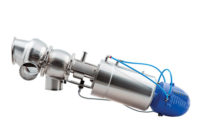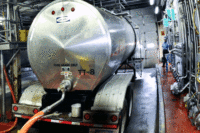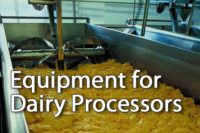Companies that build machinery to produce, trim and handle packages are a valuable resource to the package designer, says Brian Dowler of Graham Engineering, York, Pa. Their experience with a broad array of packages can benefit a dairy processor.Lessons that equipment vendors learned in one application, such as the production of bottles for non-food applications, often can be applied to produce innovative options for food packages as well, he says. Container light weighting is one example.
“The best possible package emerges when the package designer is closely in touch with the people who best understand how the package is produced – the machinery suppliers and processors,” says Dowler.
Dairy Foods invited suppliers of blow-molding equipment to share their thoughts about how dairy processors can best use this machinery. Blow-molding technologies include stretch, extrusion and injection. Vendors contacted by Dairy Foods say it is important to keep in mind that equipment makers provide more than machinery.
“At Graham Engineering, our R&D staff cooperates closely with package producers and brand companies, offering everything from complete package design to design reviews and prototype sampling,” Dowler says. “Design engineers and experienced processors work together to help optimize package designs before the first test mold is cut, leading the way to a smooth product launch.”
Turnkey system services from Tecumseh, Mich.-based Uniloy include container design, mold development and manufacturing, prototyping and preproduction runs and system commissioning. It has an extensive parts and service network.
“Creating tailored packaging solutions that meet multiple needs such as reliability, flexibility, cost and sustainability — all at the same time — is not easy,” according to the communications department of the Sidel Group, an international firm based in Switzerland. “These are perhaps four of the most important issues for leading bottlers today, but there are others too. Each company is different, and each has its own demands,” according to Sidel, whose U.S. office is in Norcross, Ga.
Jeff Newman of Wilmington Machinery, Wilmington, N.C., says his company offers economical blow-molding options.
“Processors looking for light-weight HDPE bottles for milk and yogurt drink products, or multilayer containers for barrier or hot-fill applications, will find some blow-molding systems extremely suited for their needs.”
He adds that many processors “have found rotary blow-molding systems best for these applications compared to shuttles or reciprocating screw machines. The reason: rotary systems are now the simplest to use and provide processors with the means to produce the absolute lowest-cost bottle at the highest quality level.”
Russian Dairy Is Made More Productive
In 2009, when Wimm Bill Dann (a major Russian dairy processor acquired by PepsiCo in 2011), was looking to add capacity, it turned to Uniloy, an equipment maker based in Tecumseh, Mich.
At the time, Uniloy just introduced the Neck-to-Neck (N2N) UR Series reciprocating blow-molding machines. This machine produces two containers oriented neck-to-neck per cavity in a single cycle. The result is high output with reduced energy usage and cycle times, compared to other blow-molding machine technologies.
The first two N2N machine systems were delivered to Wimm Bill Dann to produce 100-milliliter HDPE liquid yogurt containers. Each machine could produce more than 20,000 of the 6.5-gram containers per hour.
Uniloy spearheaded the container and mold design to help optimize the container, which had weighed 9 grams. This 30% weight reduction yielded three key benefits:
• The overall cost per container was reduced significantly.
• The cycle time to produce the container was reduced dramatically.
•There was a 30% reduction in the raw material reducing environmental impact to help the company meet sustainability goals.
“This turnkey, consultative approach is typical of Uniloy’s total systems thinking,” says Rich Smith, Uniloy commercial director. “As North America’s only single-source solution provider, we’re able to use technology to optimize the clients’ container design and provide customized machine systems that help them with their business needs.”
“We are extremely happy with the machines, which our staff find easy to operate and maintain,” says L. Danilushkin, chief engineer at Wimm Bill Dann. “We average over 98% efficiency on these machines and find weight variations are less than 5%. In fact, we’re so satisfied, we’ve just agreed to purchase another two lines.”
Uniloy originated the lightweight, handled, plastic milk jug in 1963, and its reciprocating blow molding machine has since become the “industry standard,” with more than 3,800 in use worldwide.
The information in this article was written by Uniloy and edited by Dairy Foods.
Sidel’s Stretch Blow-molder is Energy-Efficient
In addition to using the material polyethylene terephtalate, the machinery can also produce RPET, BioPET, Polypropylene – PP, Polylactic Acid – PLA and stretch-blow molded HDPE (high-density polyethylene) bottles.
The SBO machine has been designed to reheat PET preforms and then blow-mold bottles at high pressure. Bottles are produced with injected preforms (preforms are manufactured in an earlier stage through an injection press), according to features of the end product. The SBO can be integrated into a complete bottling line or sold as a stand-alone equipment.
Shown is a new oven design on the SBO Unversal2 Eco blow molder that requires less energy.
Krones Revamps its Stretch Blow-molding Machines
The Contiform 3 is the latest generation of stretch blow-molding machines from Krones. The blow-molding module has been entirely revamped. The field-proven linear oven of the Contiform S/H series has been design-enhanced and optimized in regard to its energy consumption. In developing the new machine, Krones had the following objectives:• Increase production output per blow-molding station
• Reduce total air consumption
• Reduce total energy consumption
• Improve hygienic design
• Shorten product changeover times, increasing flexibility
• Further enhance user-friendliness
The machine has been developed in sizes ranging from 8-36 blow-molding stations, thus enabling record outputs to be achieved of up to 81,000 containers an hour. The machine can be directly monobloc-synchronized with a filler, or in the ErgoBloc L with both a labeller and a filler.
5 Ways One Blow-molding Technology Save Money
Jeff Newman of Wilmington Machinery says single parison rotary technology saves money by giving companies the lowest cost per bottle because:
• Material cost.This is the largest area for savings. Some customers have been able to reduce the target weight by as much as 10-15%.
• Energy savings.The second largest factor is the energy savings, which could be as much as $100,000 per year.
• Real estate. Processors save floor space. A single rotary system can replace 3-4 older molders and requires less floor space.
• Labor savings.Wilmington’s system requires a single operator. This can save a processor 60-70% in labor costs.
• Operating and maintenance costs. Plant operating efficiency can improve 3-5% and a processor can save hundreds of hours annually in downtime from preventive maintenance.
Newman says a rotary machine’s simplicity “comes from the fact they are now all mechanical and uses no complex expensive hydraulics. Not only are the machines simple, they are extremely energy efficient and can save you as much as $100,000 per year in electric.”





